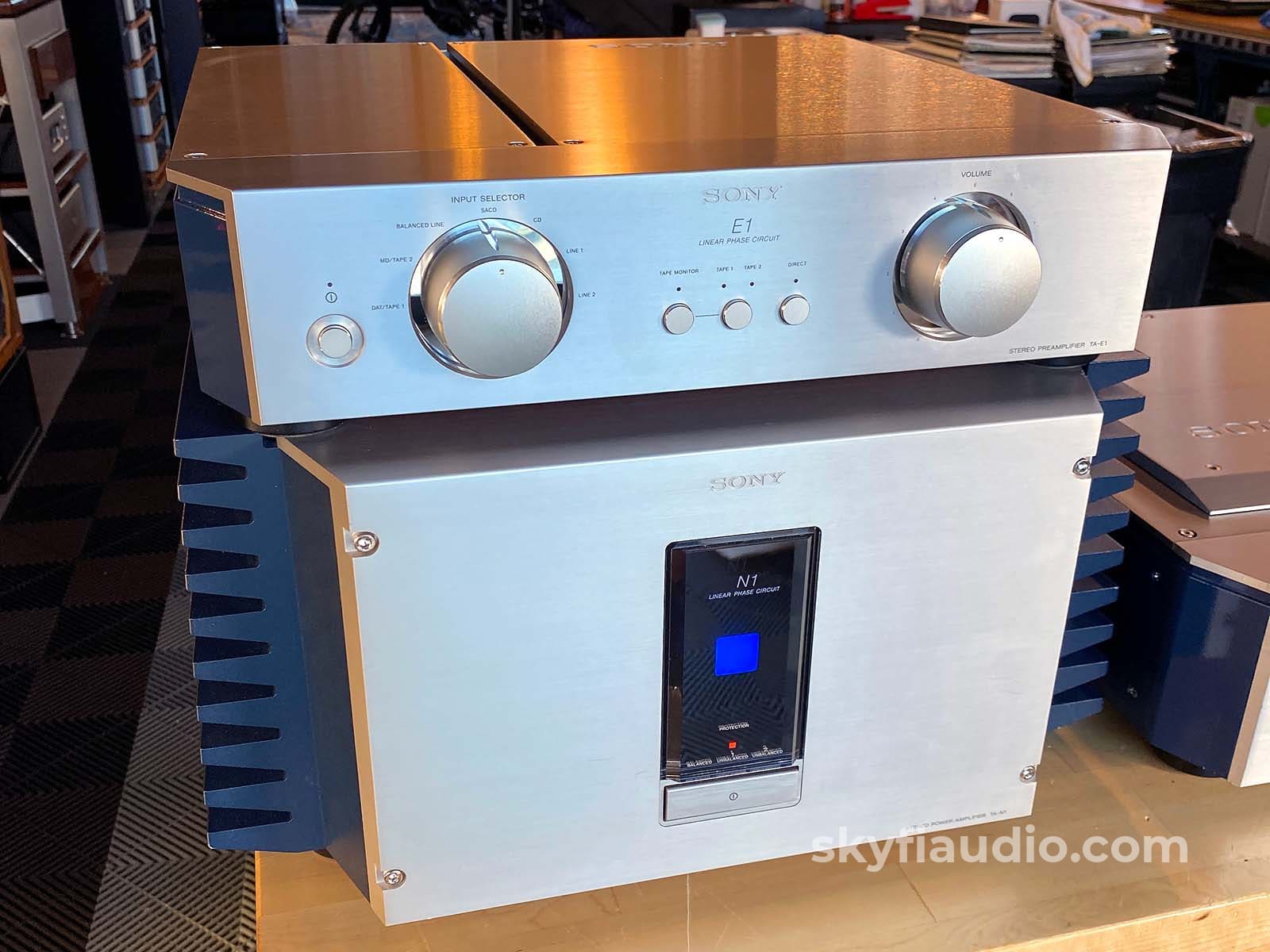
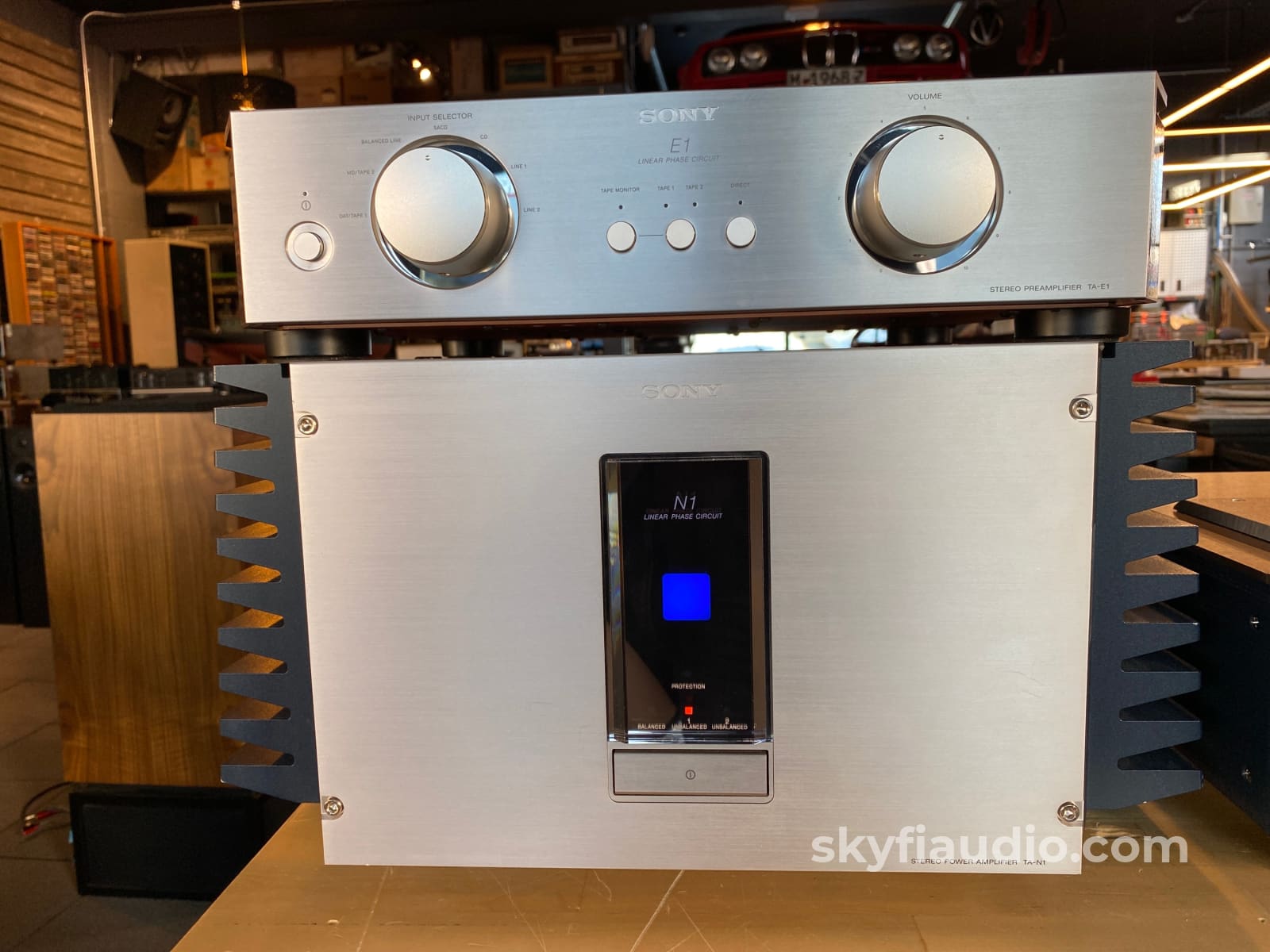
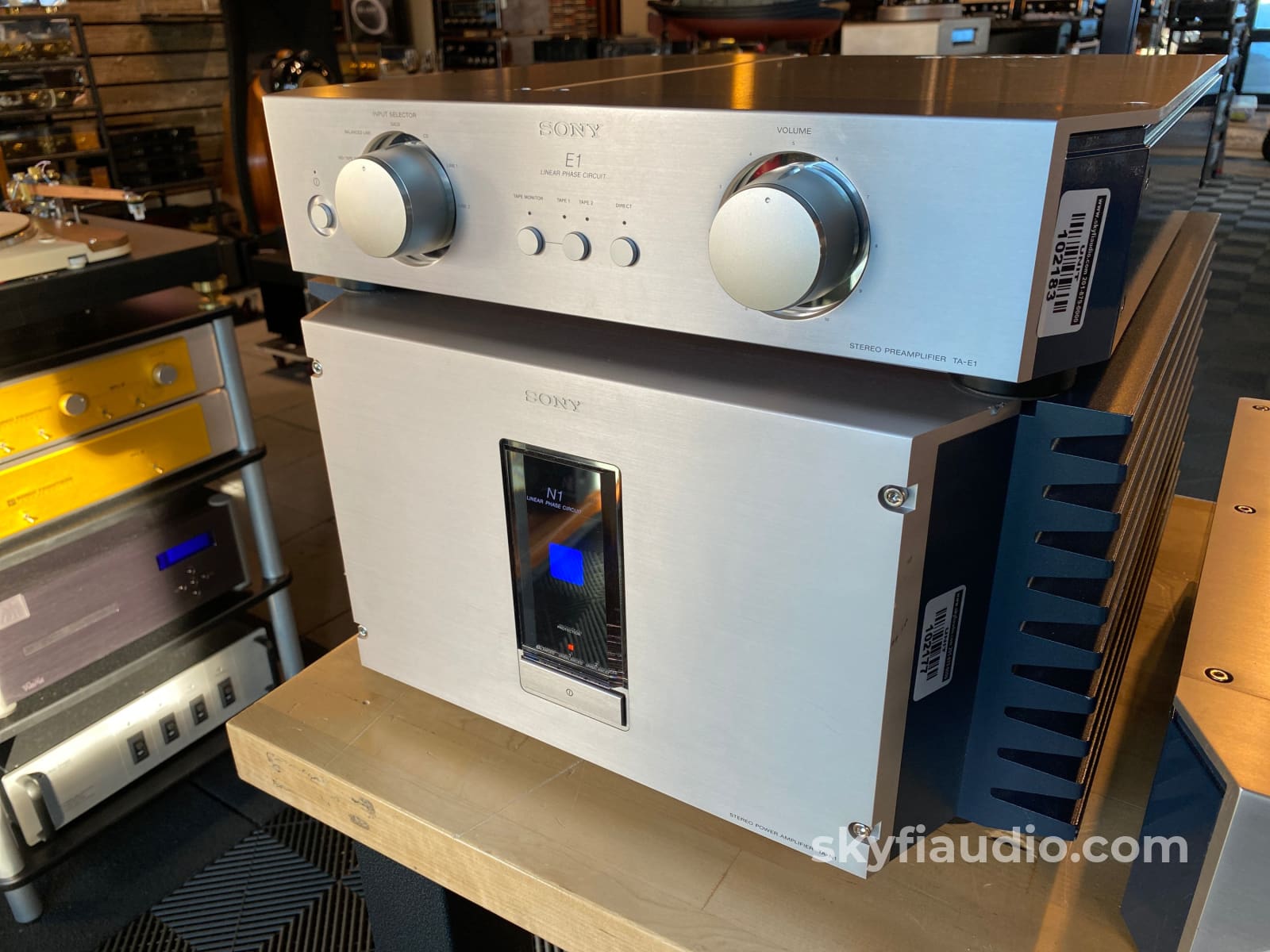
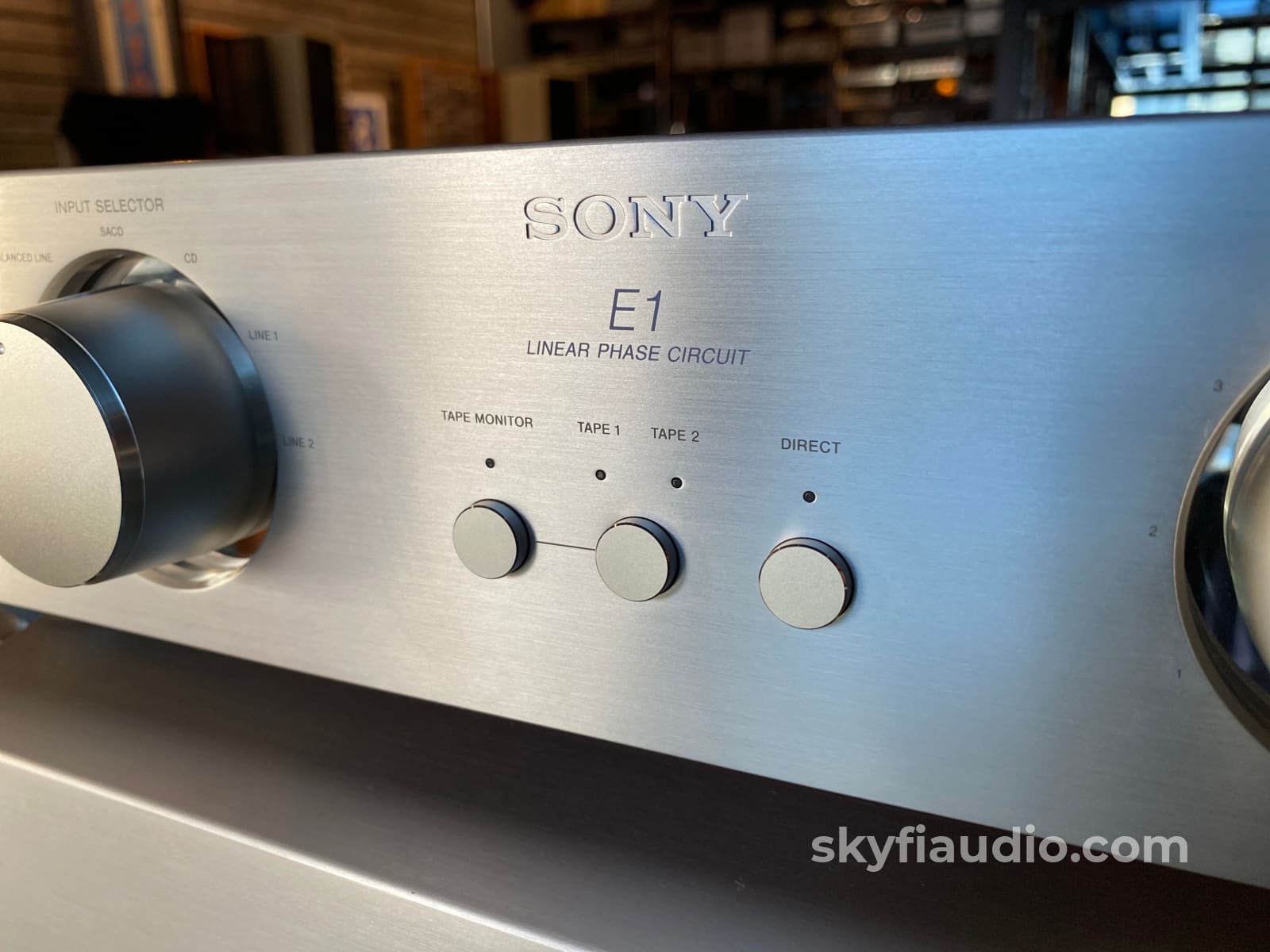
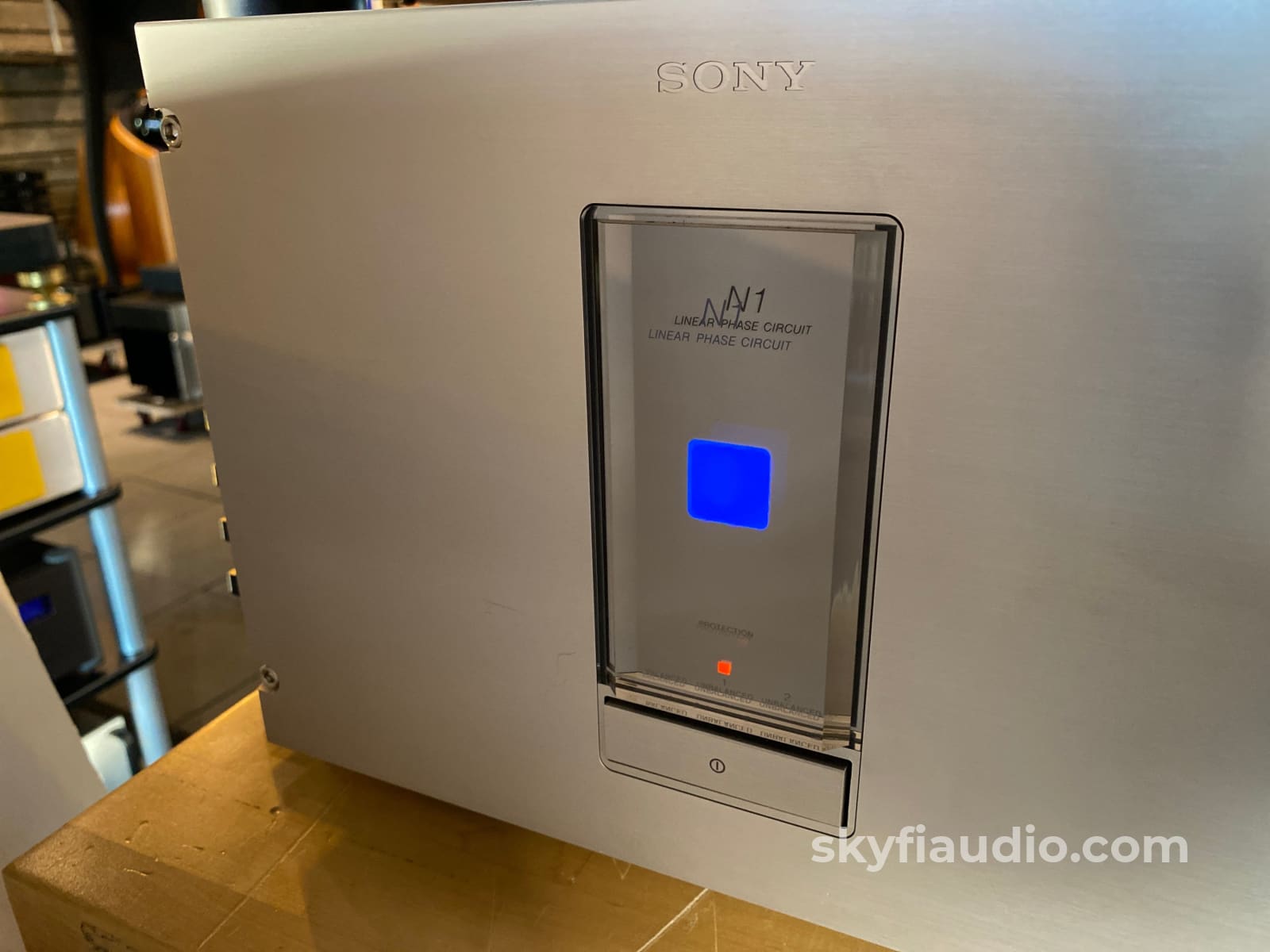
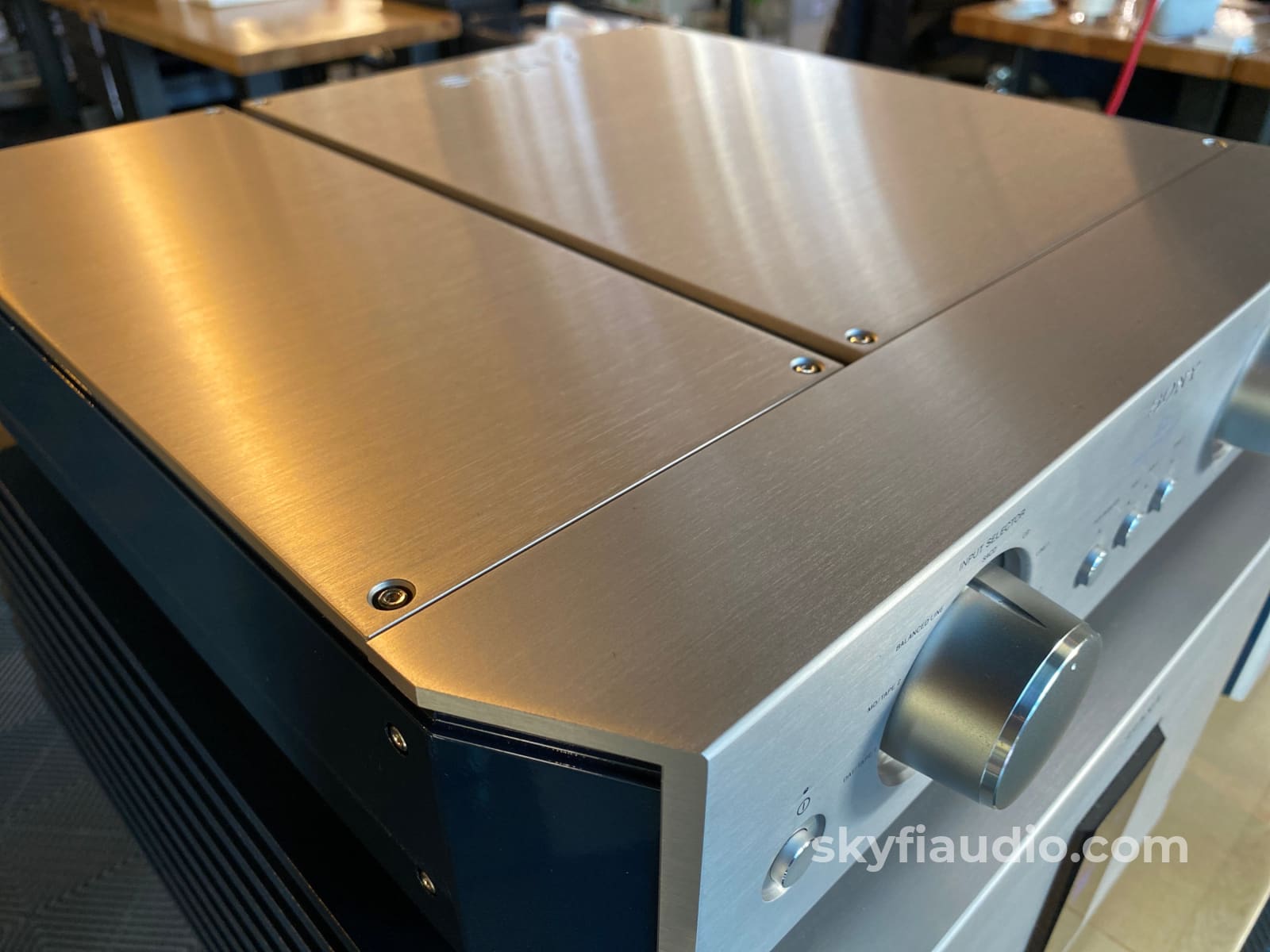
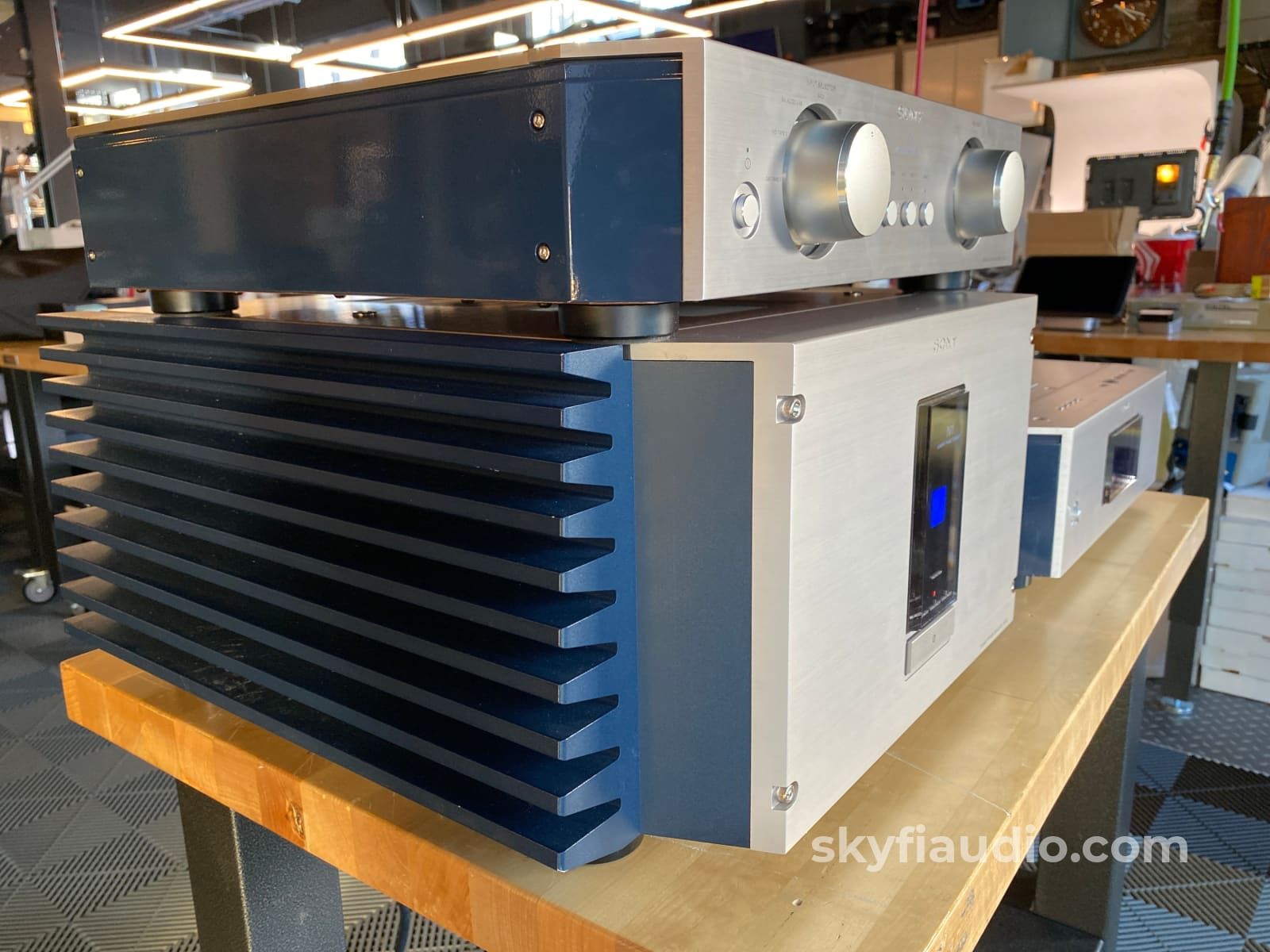
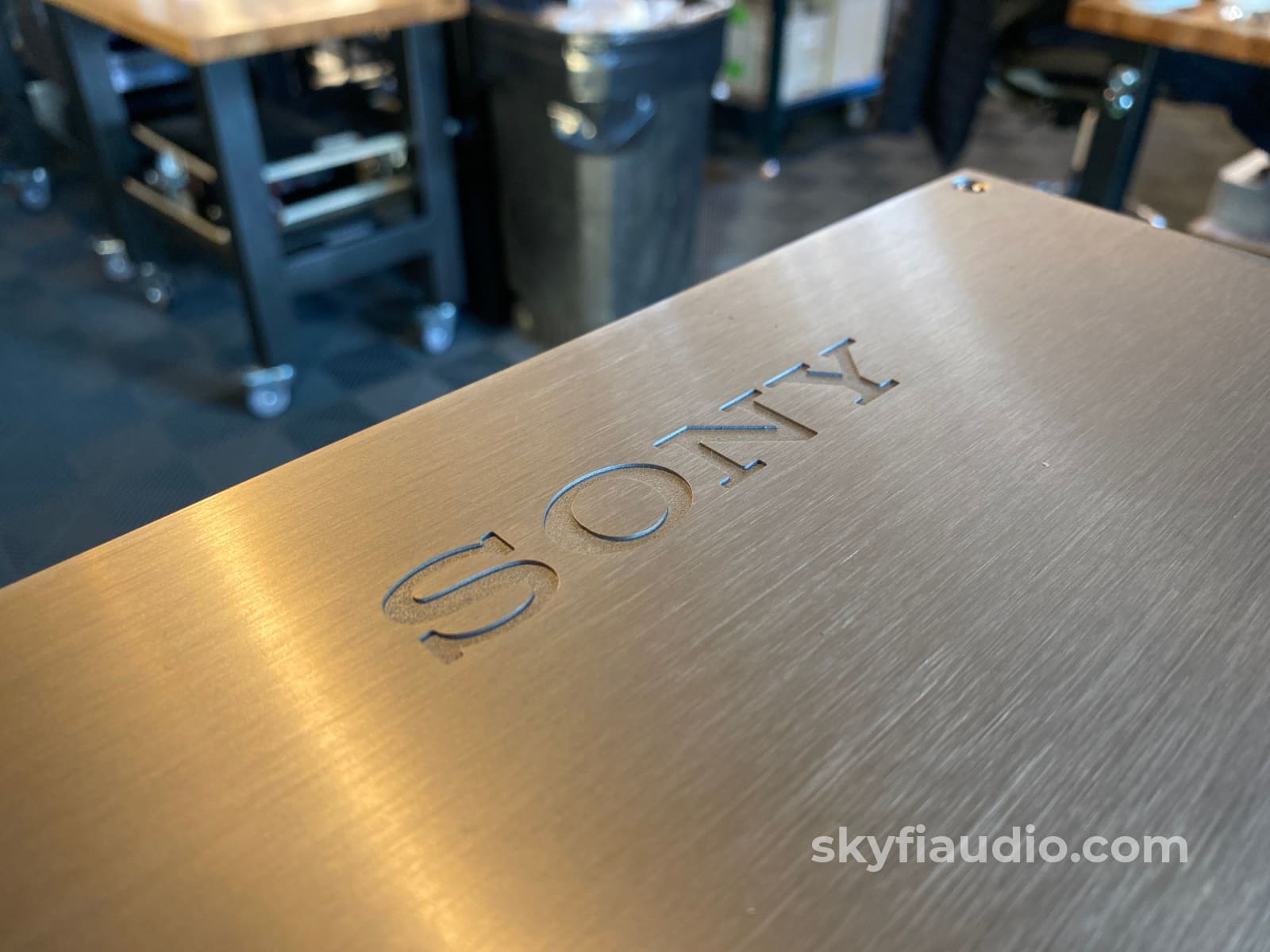
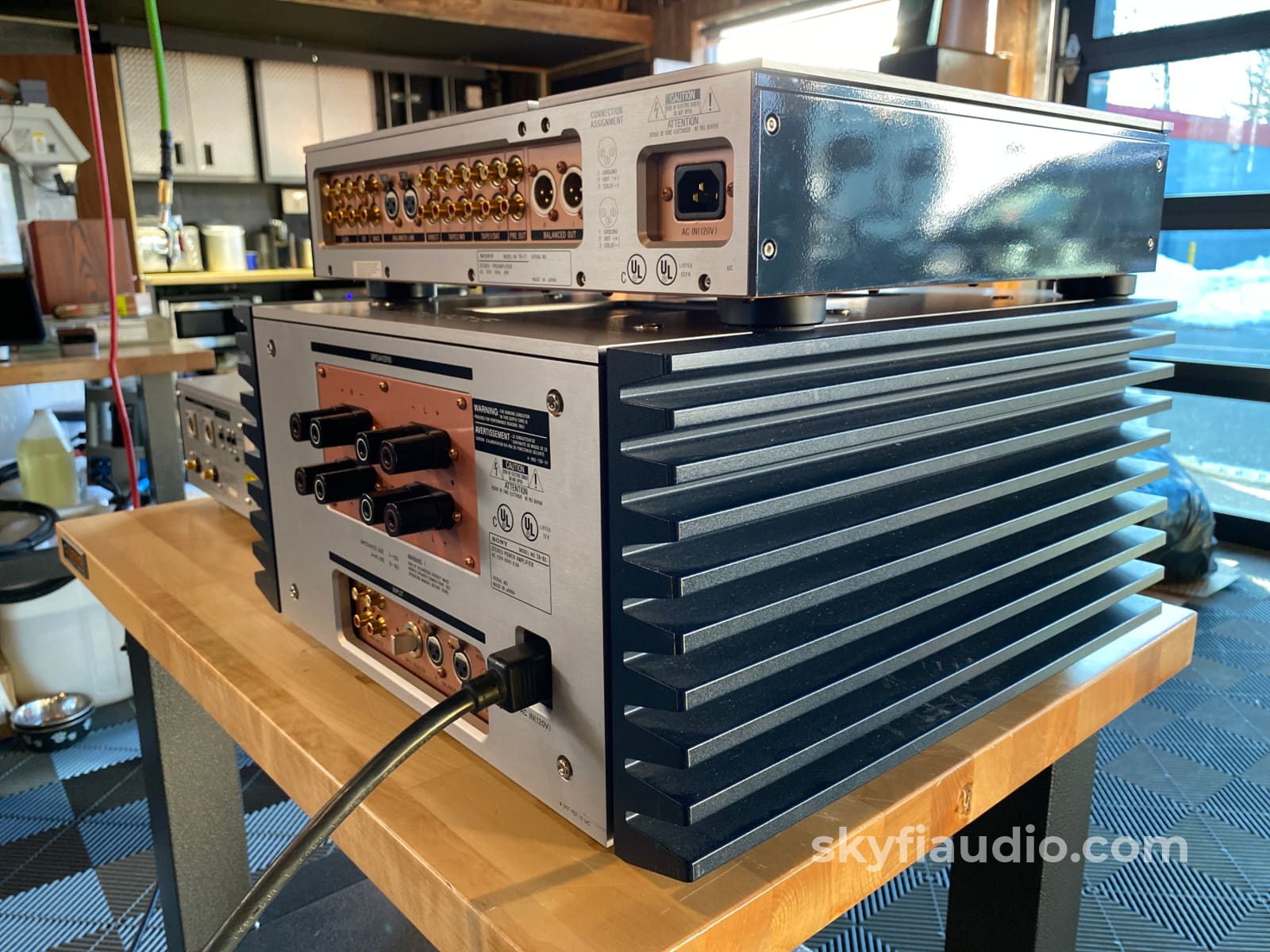
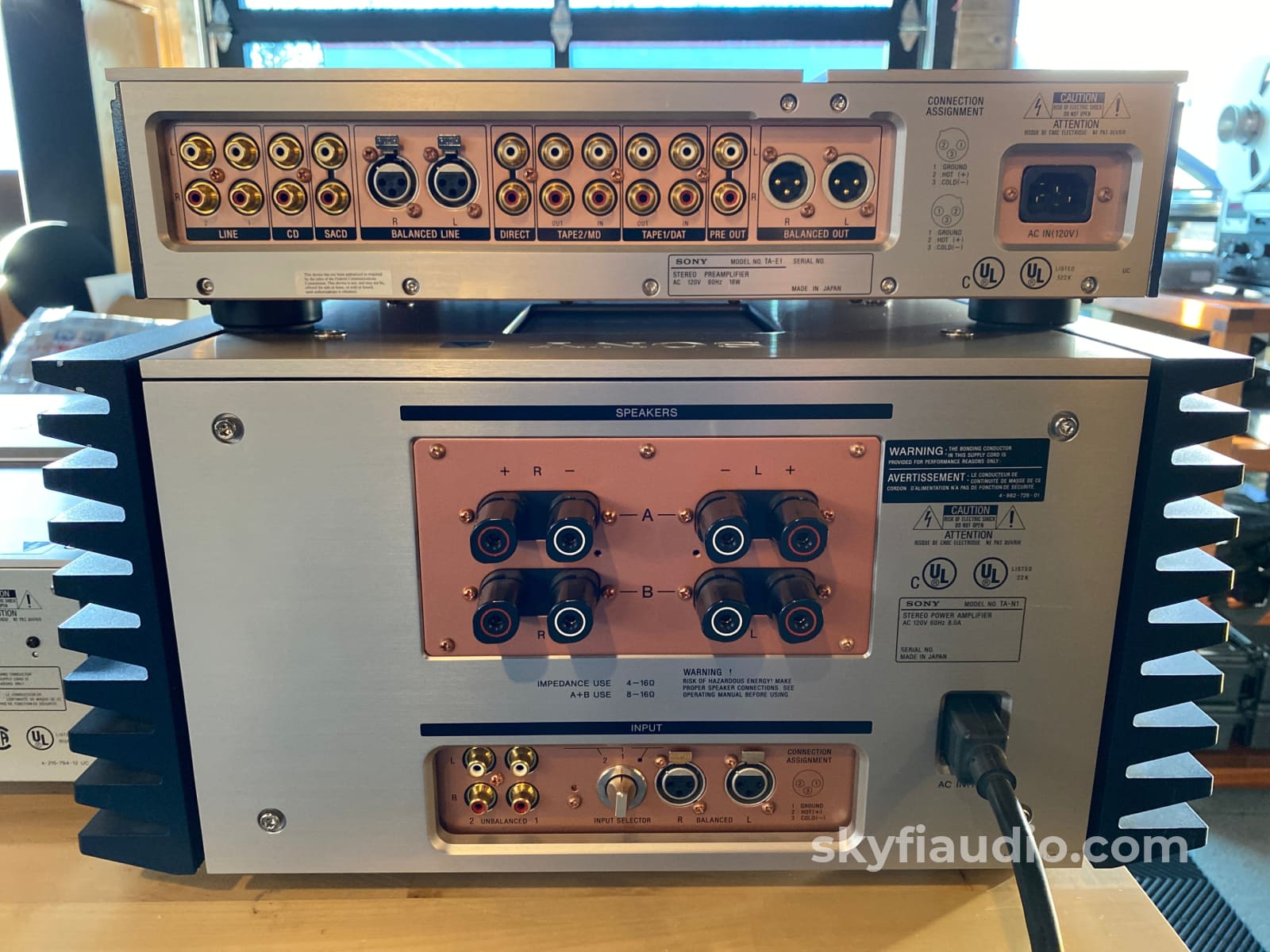
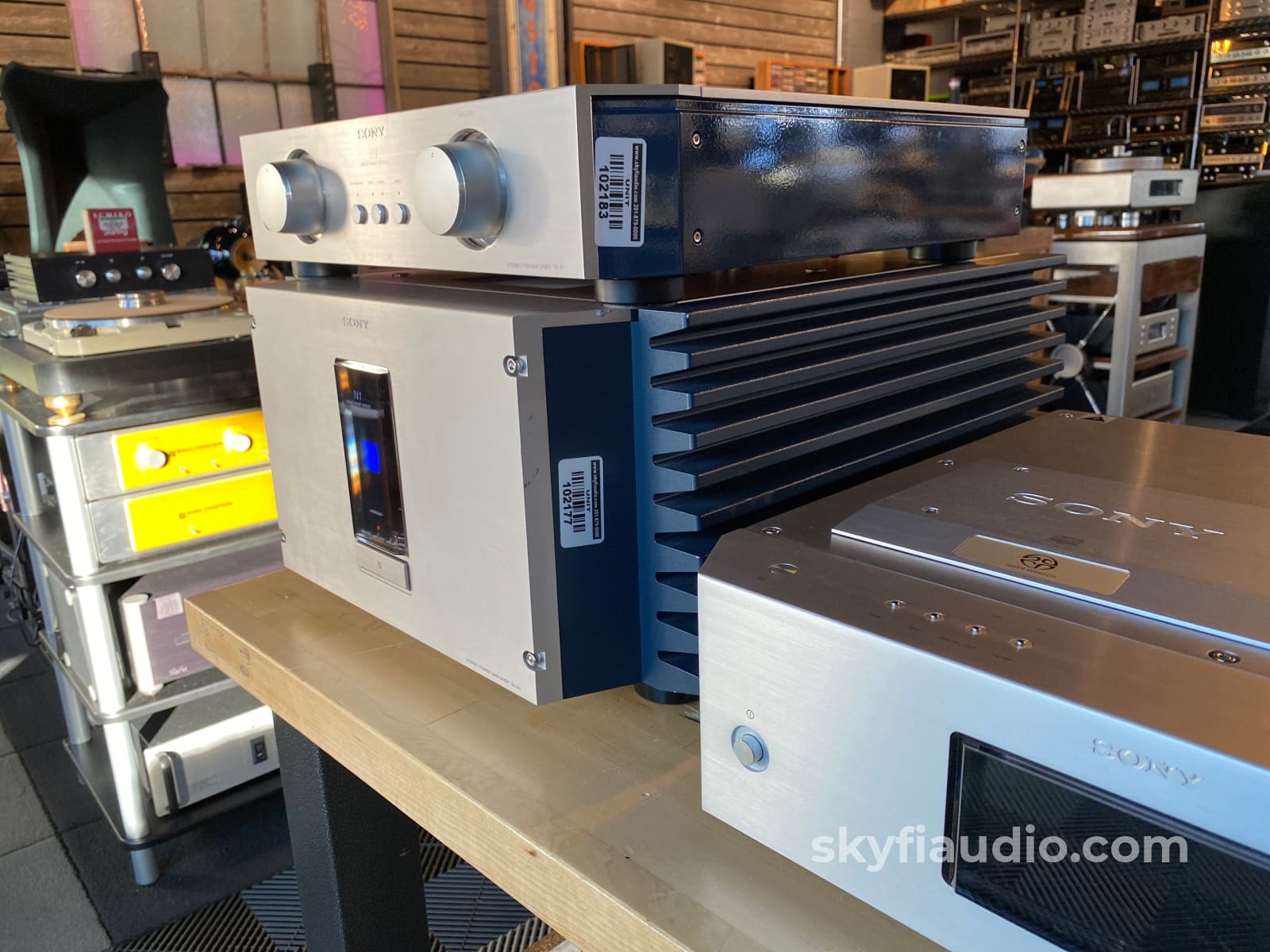
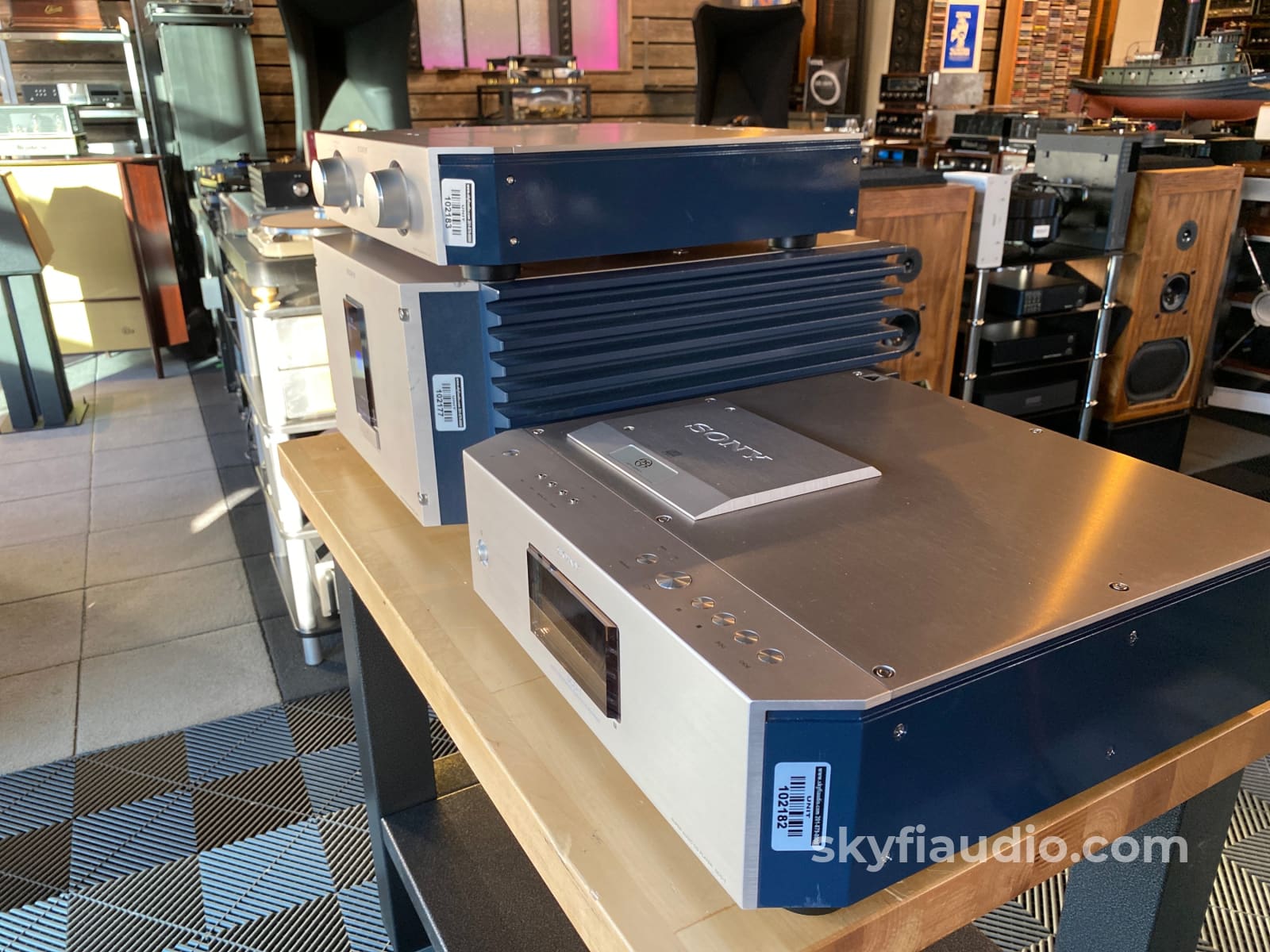
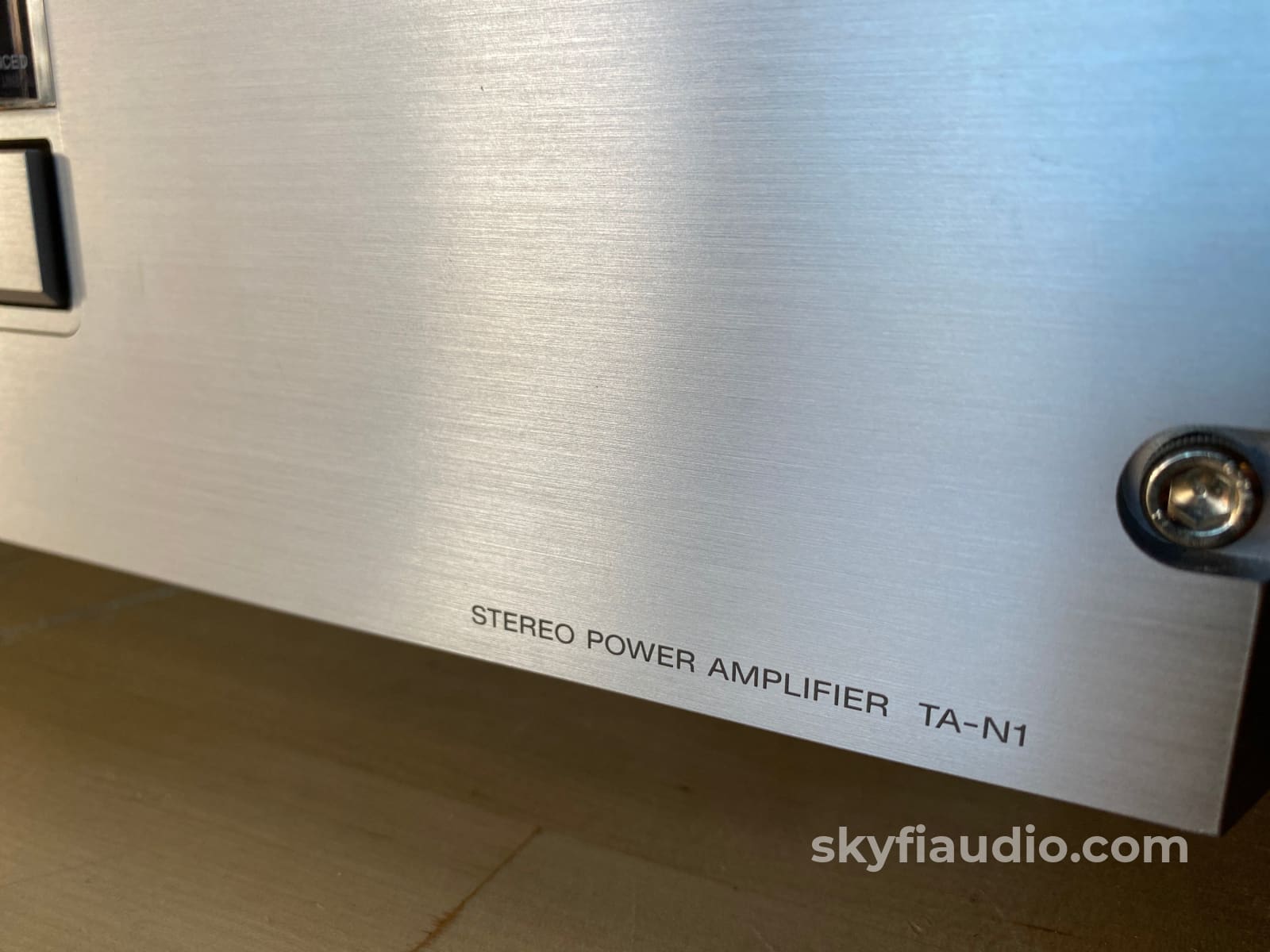
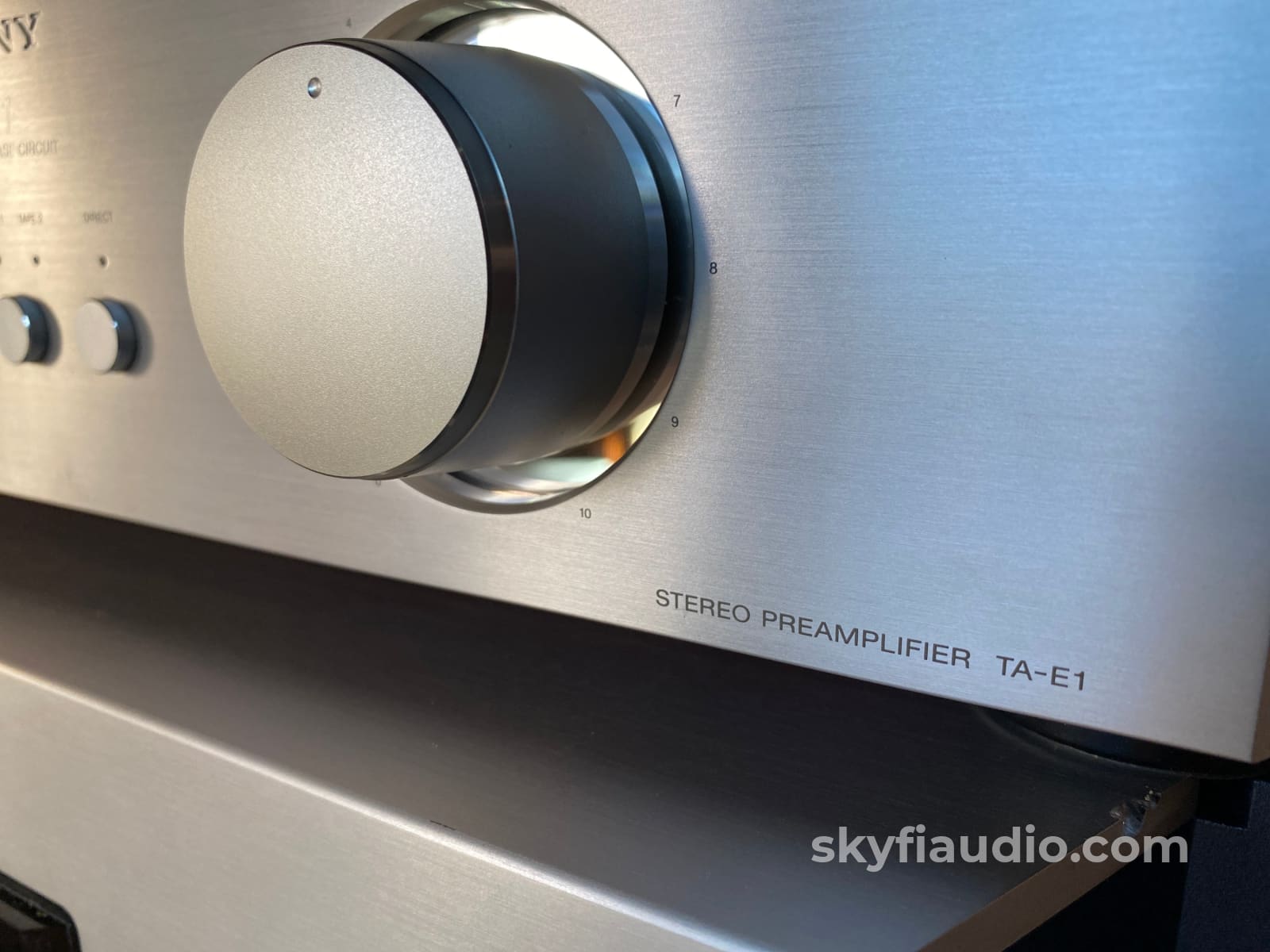
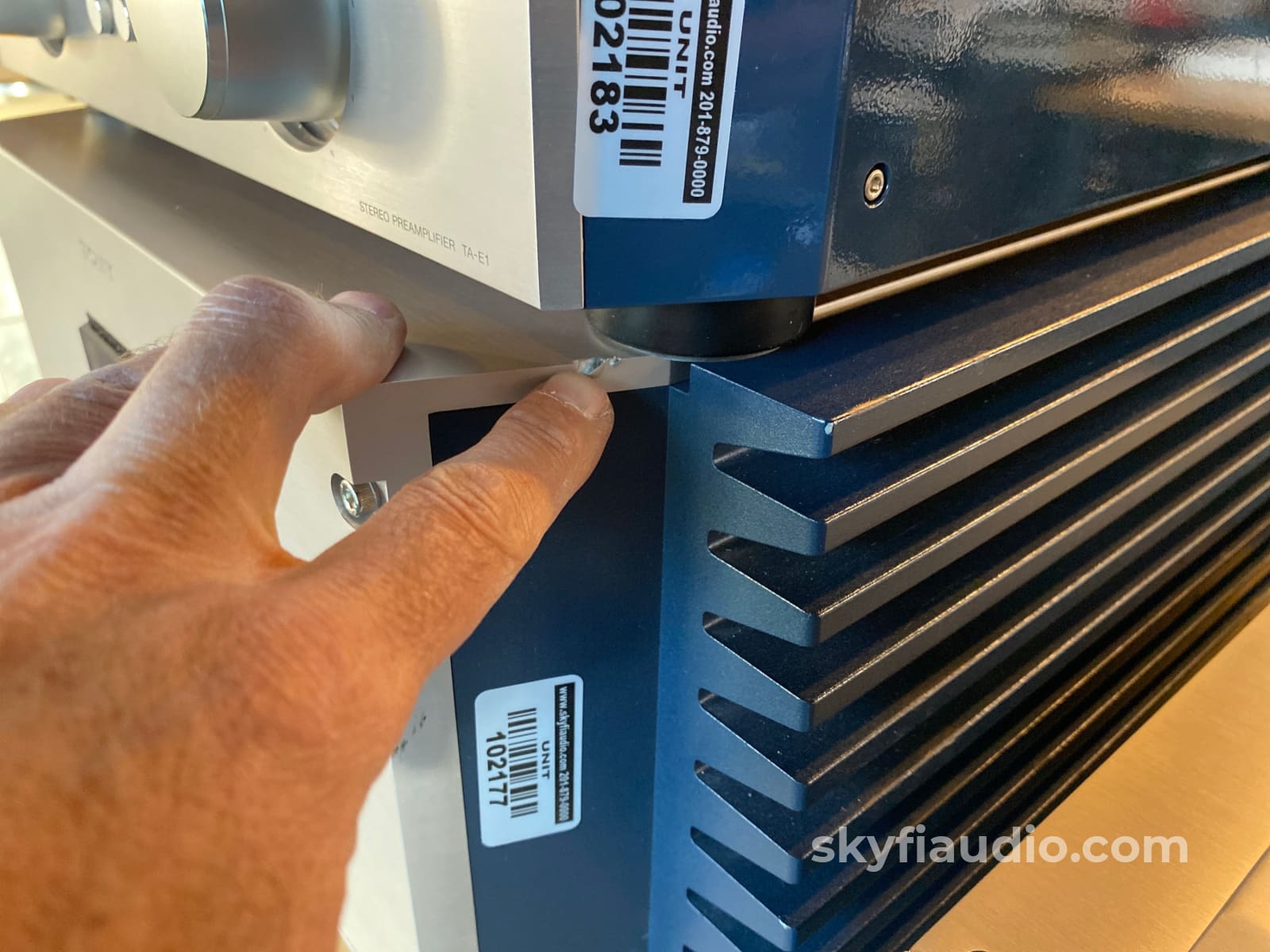
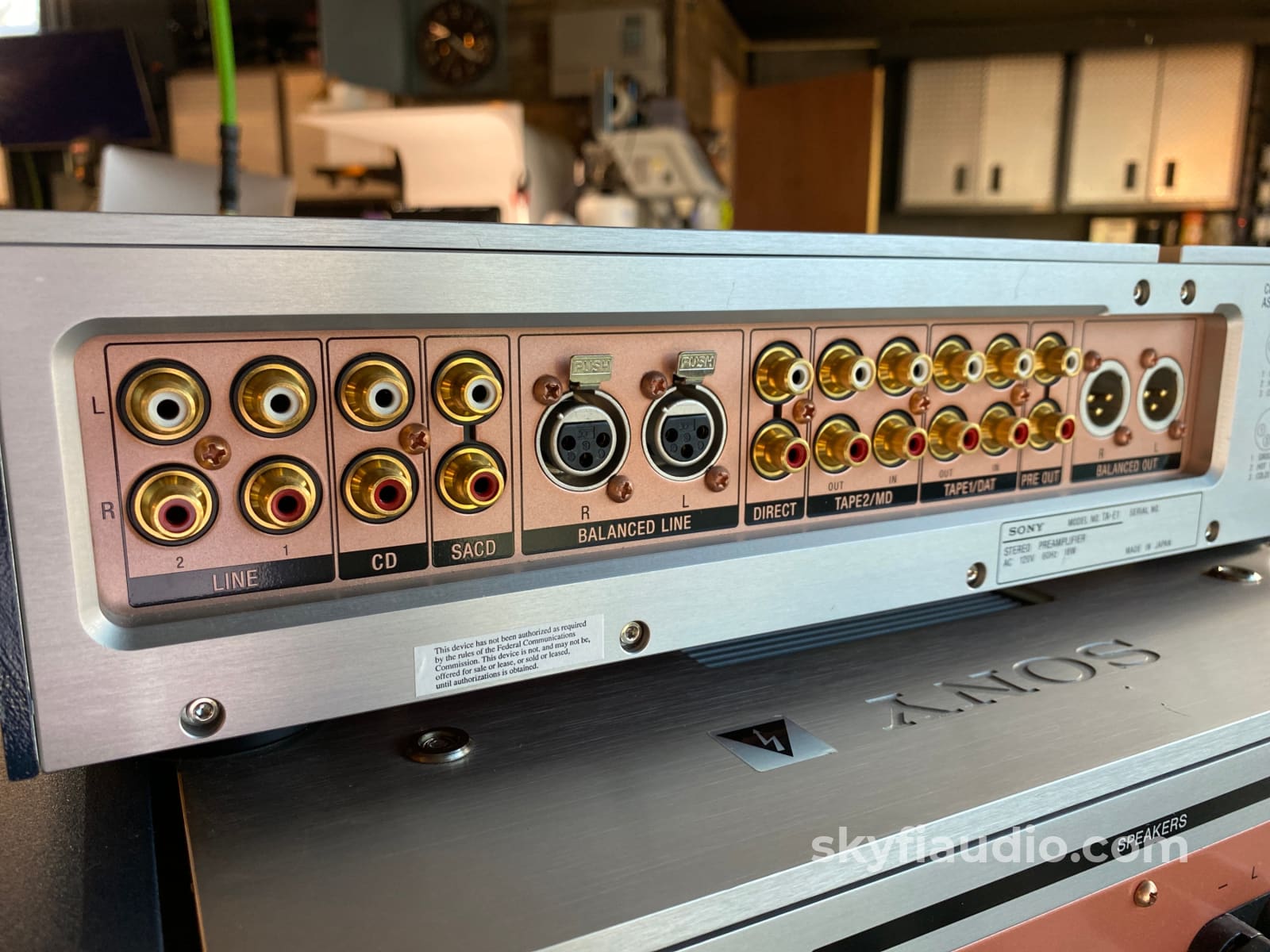
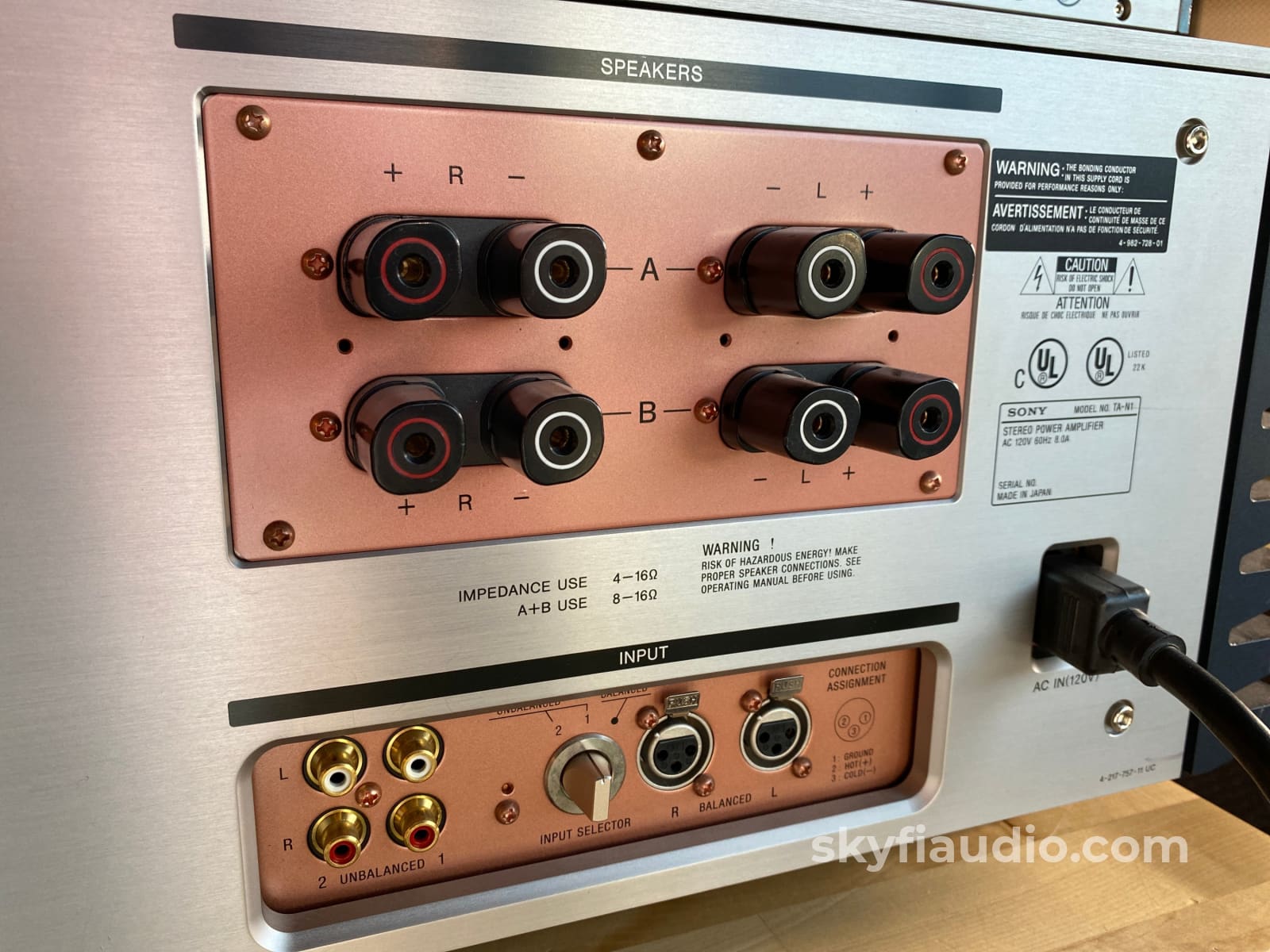
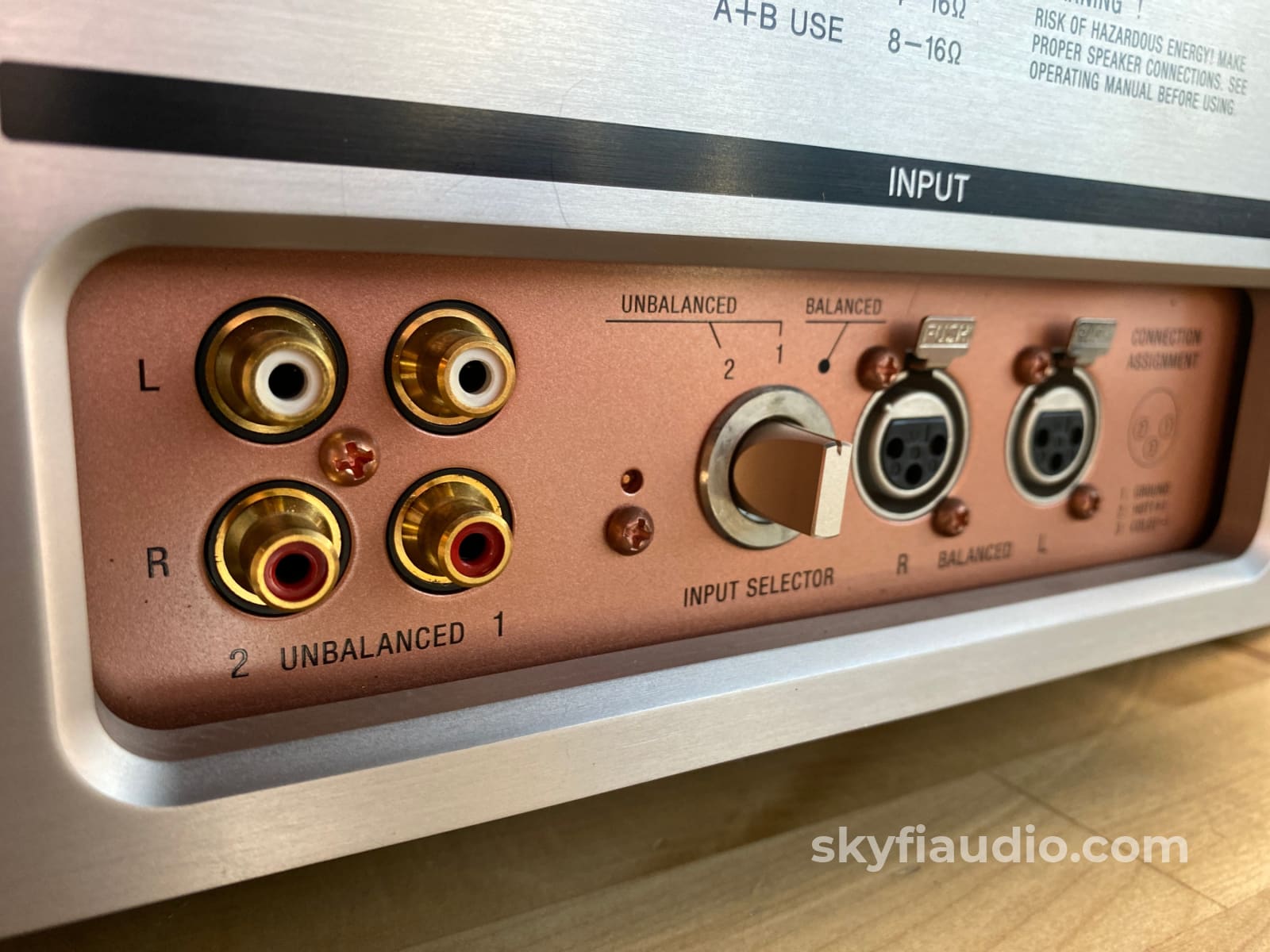
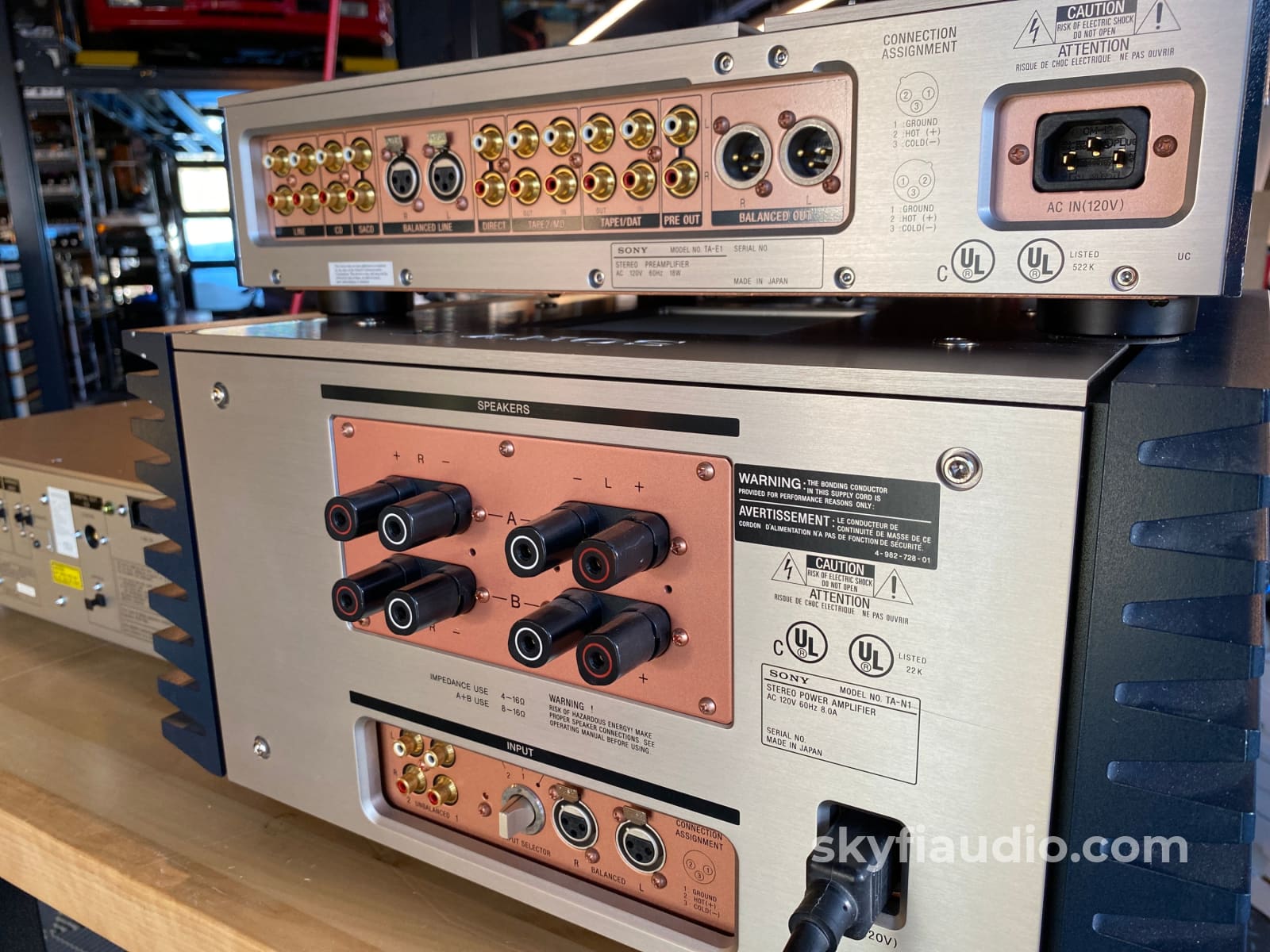
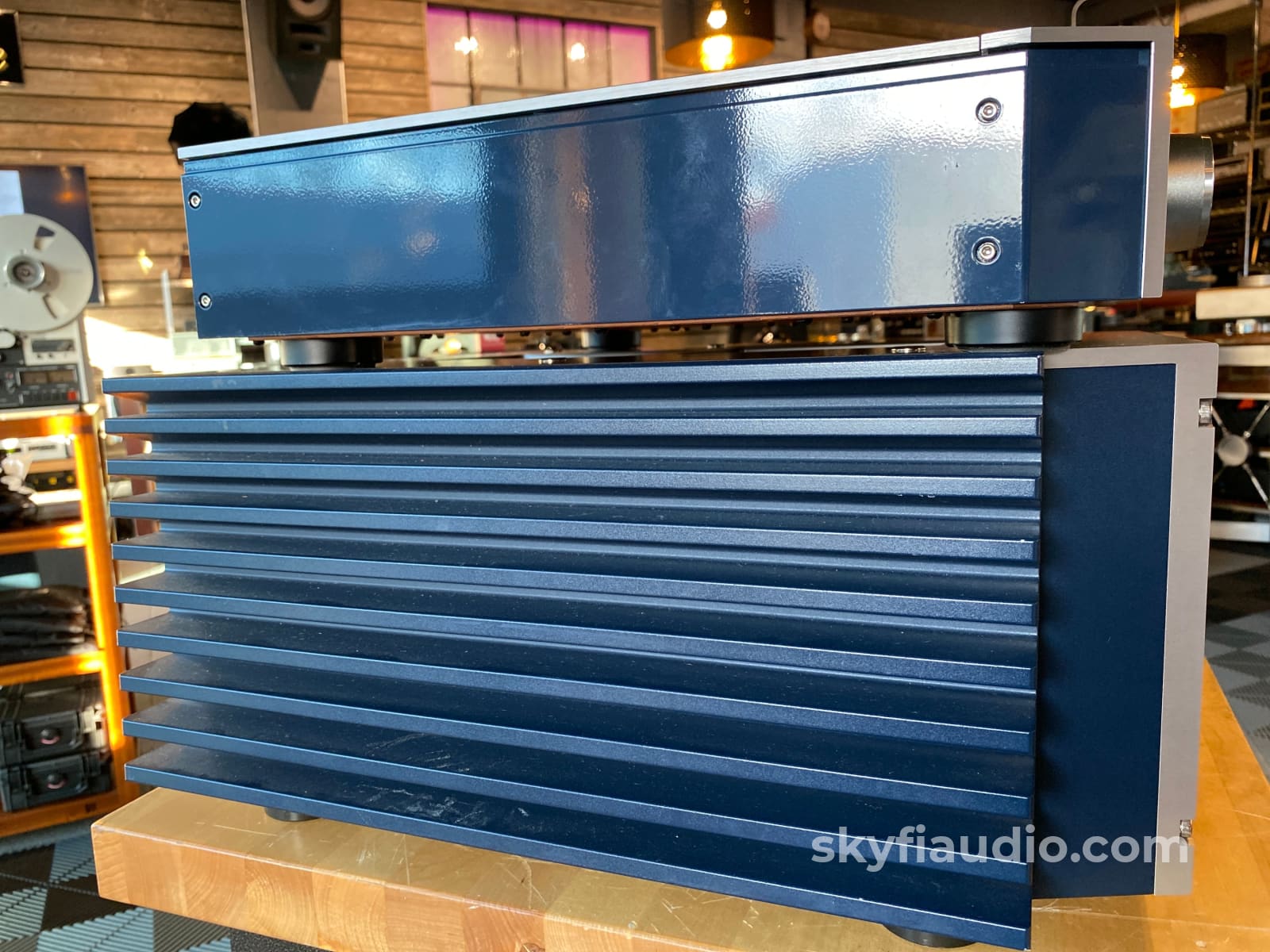
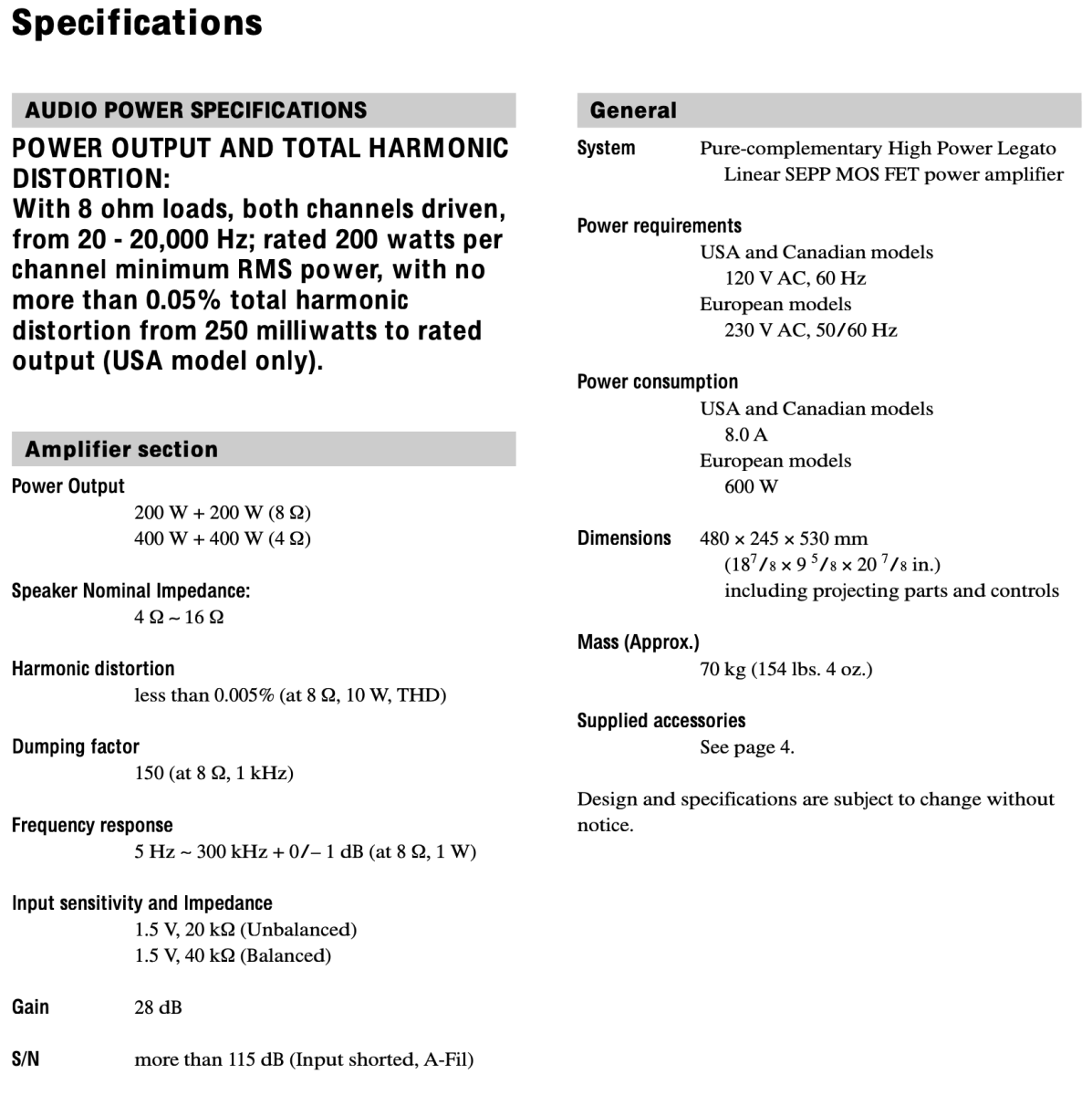
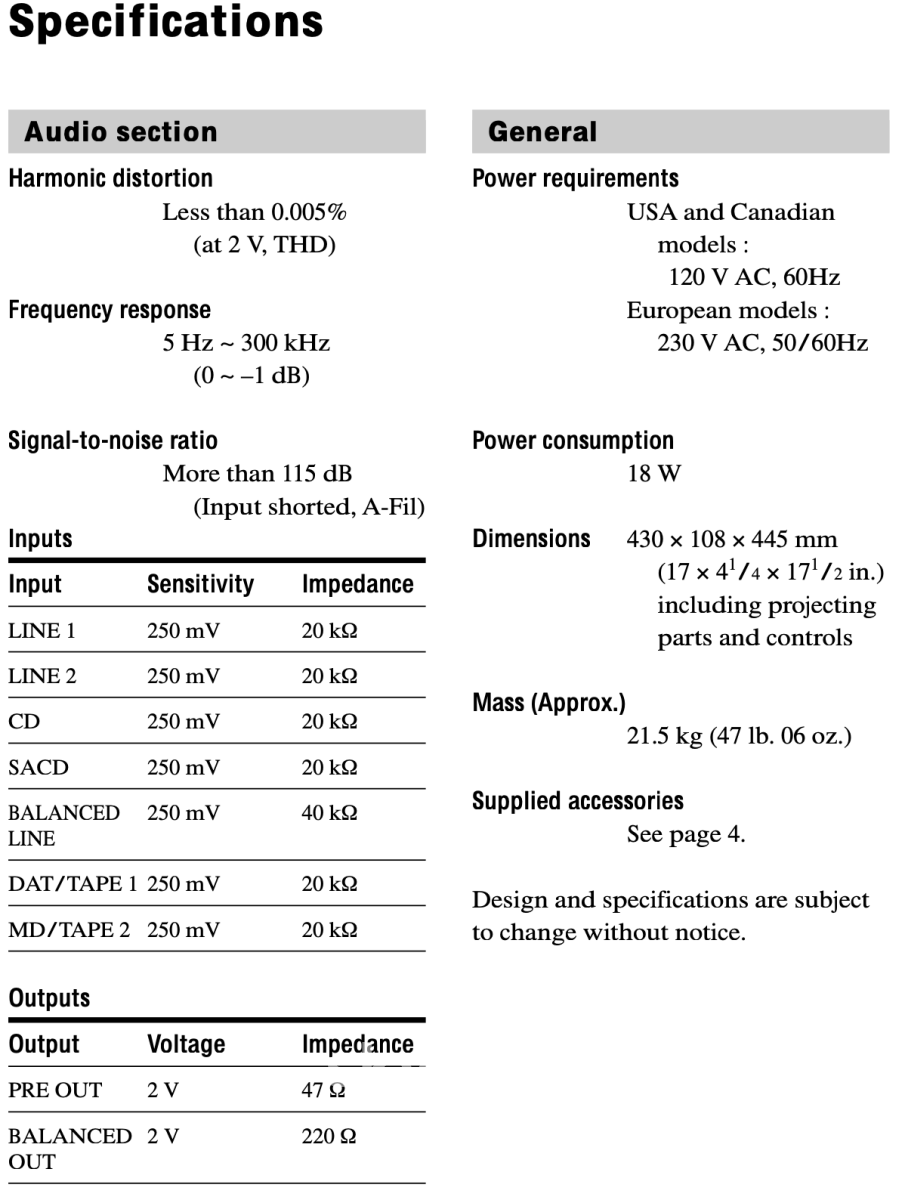
Sony ES TA-N1 Amplifier and TA-E1 Preamplifier Set - The Best Sony Ever Made
Free Shipping on Most Electronics - Excludes Speakers and Items Requiring Freight - Contiguous U.S. Only
Pickup available at SkyFi 479
Usually ready in 24 hours

Sony ES TA-N1 Amplifier and TA-E1 Preamplifier Set - The Best Sony Ever Made
SkyFi 479
479 South Broad Street
Glen Rock NJ 07452
United States
Super rare and collectible amp/preamp set from Sony, and hands down the best kit they ever produced.
One of only 100 sets EVER produced! Also known as the Sony 1 Series.
The preamp was tested and calibrated right here in our shop. The amplifier only needed testing as it was otherwise working right to manufacturer spec.
Physical condition on the preamp is a 9/10. The amplifier is rated a 7/10 because of one ding on the side metalwork.
Overall very very clean and striking.
Please note that this set is not for the weak. The amplifier alone must weigh close to 150 lbs. It will ship via Freight for a flat $500 in the lower 48 US states. Please contact us for a quote if you're outside this area, and local courier service is also available.
Your purchase also includes a custom cover.
Please see the linked manuals below or our photos for full specifications.
Sony TA-N1 Amplifier Owner's Manual
Sony TA-E1 Preamplifier Owner's Manual
Recommended Cables:
Kimber Kable - RCA Interconnects
Kimber Kable - XLR Interconnects
Kimber Kable - Bi-Wire Speaker Cables
Kimber Kable - 14AWG (Gauge) Power Cords
Kimber Kable - 10AWG (Gauge) Power Cords
More from The Vintage Knob:
Sony TA-N1 Amplifier
Part of the fairly rare "1" series, expressly designed for Sony's SACD launch, along with the SCD-1 reference player, TA-E1 preamplifier and SS-M9ED loudspeakers.
This bombastic mammoth of 70kg (155 lbs.) holds 10 pairs of non-magnetic & gold-plated Sony MOS-FETs (2SJ120A & 2SK1530A), Metal Core Modules, a non-magnetic chassis made of 15mm and 10mm aluminum slabs and copper plates, specially designed 4N aluminum foil electrolytic capacitors, a 1,5kVA Torus toroidal transformer housed in a ceramic compound, 30A rectification diodes and a fully balanced circuit and set of input plugs.
Each diecast heatsink block weighs 16kg (35 lbs.)!
The final stage is, unlike the previous TA-NR1 and its TA-NR10 updated version, setup in Class AB for a better efficiency and (much) less heat problems.
Metal Core Modules are made of an aluminium alloy circuit-board on which circuit patterns are formed with copper and parts are surface-mounted - better conductivity, better heat regulation, minimal track lengths.
To stand the bandwidth required by SACD sources, the Linear Phase Circuit was designed.
The production is supposed to have been halted after the first 100 pieces but there should be a bit more than that around the neighborood - rich neighborhoods.
Sony TA-E1 Preamplifier
Part of Sony's last series of High-End units, specifically designed for the SACD format and the SCD-1 flagship - all with outer-space bandwidth requirements.
As for the xxx-rare R10 units, no expense was spared for the "1" mini series. High-bandwidth oblige, the star of the show is the Phase Linear Amplifier, allowing phase to remain linear up to 100Khz, with only 5dB attenuation around the 100MHz region !
The chassis of the TA-E1 is a sandwich of 1cm aluminum and 2 x 2mm copper plates; the top plate is 7mm thick, enlarged to 10mm for the front and back parts.
Power supply and rectification are set in a separate enclosure, very much like the pre-Esprit preamplifiers :)
The resistive plastic ALPS attenuator has a 5cm diameter and allows channel balance error of only 0.5dB between 0dB and -100dB; depth is of 9.5cm while the structure of it is full oxygen-free copper made under hot casting conditions. Ultra-low resistance plastic is used.
The power transformer is "amorphic" and toroidal with ultra-magnetic materials (nickel, cobalt, and iron) used for the metal core and precise winding arrangement; it is housed in a ceramic box for optimal damping and avoidance of any possible flux leaks.
The four die-cast Metal Core Modules hold the input/output stages PCBs and are used as heatsinks as well (decoupling the boards from the chassis along the way) and as components are surface mounted, shortening signals paths as well.
The rest of the parts is on par with all the above, and so was the pricetag.
How many E1's were produced is a mystery: it is even said that only the initial production was completed - that would make 100. However, the highest serial spotted outside Japan was #500 104 and outside Japan a bit lower than that. So probably around 200 made - few at any rate.
But then, as a prospective replacement to CD, SACD wasn't that successful either...
Sony in 2004 sort of launched a Japan-only and even more reduced set of high-end separates (SCD-DR1, TA-DR1 and TA-DR1a) with this time really undefendable design à la melted ice cream.
The DR1 set ended Sony's adventure in high-end audio (bar the SS-AR1 loudspeaker all-time masterpiece).
But you can still read the enthusiastic april 1999 Sony press announcement online.
The SkyFi Testing Process for Solid State Preamplifiers:
We start with a visual inspection of all internal components to make sure that there are no signs of heat stress or damage. Capacitors are checked for telltale signs of predictive failure including bulging, shrunken wrappers, or physical leakage. We also inspect the PCB’s for discoloration from resistors or transistors that may have been running hot. On vintage units we often spot check select capacitors for value and ESR.
When we first power on a preamplifier we connect its RCA output to a Sencore PA81 Power Analyzer which simulates real world loading conditions and gives us an oscilloscope interface. The first order of business is checking that the volume control works smoothly throughout its entire range with acceptable channel balance. This is accomplished by feeding a 1KHz sine wave into one of the preamp’s line level inputs while monitoring the preamp’s output on an oscilloscope. We then switch to a 1KHz square wave to test the tone controls, loudness function, and filters where applicable. During this step we are watching for equal alteration of the test signal by both channels. This also helps us identify dirty controls that will need treatment. Once the basic line stage functions are verified, we test each input individually. This is especially important for devices that use relays to select their sources. If the preamp is equipped with a phono stage we test that as well. We use an inverse RIAA filter which allows us to feed a reference test signal into the phono input with the proper RIAA equalization and level. A square wave or sine sweep is used to verify that the device’s phono stage is faithfully reproducing the RIAA curve. If the preamp under test has balanced inputs and/or outputs these are tested as well.
We finish up our bench testing with a listening test with our bench amplifier and reference speakers. During this test we check for hum or hiss that may not have shown up in earlier testing. We also check that all of the tone controls and filters perform as expected. If the preamplifier has remote control functions these are also tested. Preamps with tube circuits or complicated power supply topologies are connected at our long term test rig for extended stress testing under real world conditions.
The SkyFi Testing Process for Solid State Amplifiers:
We start with a visual inspection of all internal components to make sure that there are no signs of heat stress or damage. Capacitors are checked for telltale signs of predictive failure including bulging, shrunken wrappers, or physical leakage. We also inspect the PCBs for discoloration from resistors or transistors that may have been running hot. On vintage units we often spot check select capacitors for value and ESR.
If the amplifier passes visual inspection, we move on to a controlled power on sequence using a Sencore safety analyzer to monitor current draw in real time. Once the amplifier is determined to be safe to operate, we connect it to full AC mains for function and power testing. We connect the speaker outputs of the amplifier to a Sencore PA81 Power Analyzer which acts as a dummy load, DC offset monitor, and oscilloscope interface. We start with a low level 1KHz test signal at the amplifier’s input and slowly increase its amplitude while monitoring the output on an oscilloscope for signs of noise, clipping, distortion, or improper channel balance. We continue increasing the signal level until the amplifier reaches clipping. At this point we take an output power measurement and compare it to the spec sheet of the amplifier to verify proper performance. If the device under test has both balanced and single ended inputs they are both tested at this time. We finish off the bench evaluation with a 1KHz square wave check and a 20Hz to 20KHz sine sweep to assess the amplifier’s frequency response characteristics. This battery of tests will usually reveal if the amplifier has any issues that need further attention.
Before the device leaves the bench, we perform a listening test with actual music using a variety of preferred test tracks. Our benches are outfitted with familiar monitor speakers which help us identify inconsistencies that will not always show up on our test gear. The main things that we are listening for are hum or noise with no signal present, proper center image, clicks, pops, or any other obvious undesirable audio characteristics.
If the unit passes all of these tests it is moved to our long term testing rig where we simulate real word operating conditions for 6-8 hours. This allows us to monitor the unit for signs of thermal runaway or intermittent issues that only crop up when the unit has fully come up to temperature.
|
Item |
Included |
|
Original Box |
No - Not Included |
|
Manual |
No - Online Only |
|
Remote |
No - Preamp does not have remote control capability |
|
Cables |
Yes - Power Only |
|
Physical Condition |
7 / 10 |
|
Working Condition |
10 / 10 |
Choose options






















